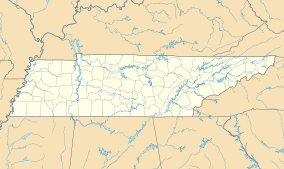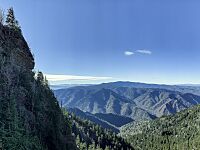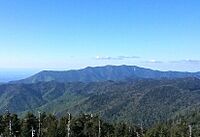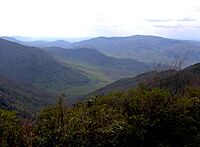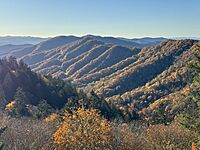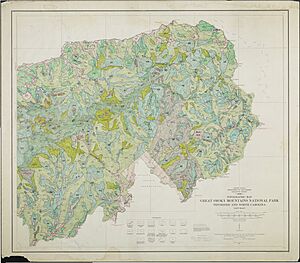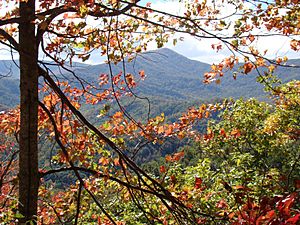Great Smoky Mountains National Park facts for kids
Quick facts for kids Great Smoky Mountains National Park |
|
|---|---|
|
IUCN Category II (National Park)
|
|
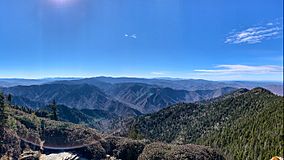
View from the Cliff Tops formation atop Mount Le Conte
|
|
| Location | Swain & Haywood counties in North Carolina; Sevier, Blount, & Cocke counties in Tennessee, United States |
| Nearest city | Cherokee, North Carolina, Bryson City, North Carolina, Townsend, Tennessee, Cosby, Tennessee and Gatlinburg, Tennessee |
| Area | 522,419 acres (2,114.15 km2) |
| Established | June 15, 1934 |
| Visitors | 14,137,812 (in 2020) |
| Governing body | National Park Service |
The Great Smoky Mountains National Park is a special place in the southeast. It's a national park that stretches across parts of North Carolina and Tennessee. The park sits on top of the Great Smoky Mountains, which are part of the larger Appalachian Mountain chain.
This park is home to some of the tallest mountains in eastern North America. These include Kuwohi, Mount Guyot, and Mount Le Conte. The border between Tennessee and North Carolina runs right through the middle of the park. The famous Appalachian Trail also goes through the park.
The Great Smoky Mountains National Park is huge, covering about 522,419 acres (2,114 km²). This makes it one of the largest protected areas in the eastern U.S. It's also the most visited national park in the United States, with over 13 million visitors in 2023!
People love this park for its amazing mountains, beautiful waterfalls, and diverse forests. It's also known for its many different kinds of plants and animals. Plus, the park keeps old buildings safe that show how early European-American settlers lived here.
The United States Congress created the park in 1934. President Franklin D. Roosevelt officially opened it in 1940. It was the first national park to get money from the federal government to buy land. Other parks before it were paid for by states or private groups. The park is so special that UNESCO named it a World Heritage Site in 1983. It also became an International Biosphere Reserve in 1988.
The park helps a lot with tourism in nearby towns like Gatlinburg, Tennessee. Places like Dollywood and Ripley's Aquarium of the Smokies are big attractions. Tourism to the park brings in about $2.5 billion every year for the local area.
Contents
Exploring the Park's Geography
The Great Smoky Mountains National Park covers a huge area. It's split almost equally between Tennessee and North Carolina. The park is located in Blount, Sevier, and Cocke Counties in Tennessee. In North Carolina, it's in Swain and Haywood Counties.
The park is next to an Indian reservation to the south. This is where the Eastern Band of Cherokee Indians live. They are descendants of Cherokee people who stayed in the area. The town of Gatlinburg is just north of the park. Other nearby towns include Townsend in Tennessee and Bryson City in North Carolina. The Cherokee National Forest and Nantahala National Forest also border the park.
What Mountains Are in the Park?
The Great Smoky Mountains National Park protects most of the Great Smoky Mountains. These mountains are part of the larger Appalachian Mountains. The mountains generally run from east to west.
The park has mountains that range from about 875 feet (267 meters) to 6,643 feet (2,025 meters) high. Kuwohi is the tallest mountain in the park. It's also the highest mountain in Tennessee. It's the third-highest mountain east of the Mississippi River.
The park has 16 mountains that are taller than 6,000 feet (1,829 meters). These are called the "Southern Sixers." Mount Guyot is the second-highest mountain in the park, at 6,621 feet (2,018 meters). Mount Le Conte is 6,593 feet (2,010 meters tall). It rises 5,301 feet (1,616 meters) from its base. This makes it the tallest mountain in the eastern U.S. when measured from base to summit.
Between the mountains, you'll find deep valleys called "coves." The biggest and most famous is Cades Cove. This is a wide, flat area between the main mountains and smaller hills. Other important valleys include The Sugarlands, Greenbrier, and Ocanaluftee. These valleys are easy to reach and are popular spots in the park.
-
Kuwohi is the highest mountain in the national park at 6,643 feet (2,025 meters).
-
Mount Le Conte is the tallest mountain in eastern North America, measured from base to summit.
-
The Sugarlands is one of several important valleys in the park.
-
A view of the mountains from Newfound Gap.
Rivers, Streams, and Waterfalls
The Great Smoky Mountains National Park is part of the Tennessee Valley. This means all its water flows into the Tennessee River. The park has about 2,900 miles (4,700 km) of streams.
Many rivers start in the park. These include the Little Pigeon River, the Oconaluftee River, and the Little River. The park is also home to over 100 amazing waterfalls.
The tallest waterfall is Ramsey Cascades. It drops 100 feet (30 meters) over rocks into a small pool. Rainbow Falls is the tallest single-drop waterfall. It plunges 80 feet (24 meters) down. Other popular waterfalls are Grotto Falls, Laurel Falls, and Abrams Falls.
Historic Places to Explore
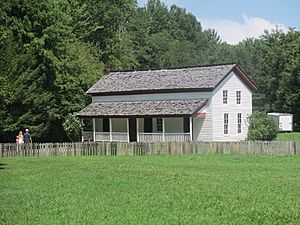
The park protects many old buildings and areas that tell stories of the past. There are four historic districts and one archaeological district. These areas show how people lived long ago.
Some famous historic places include:
You can also see individual historic buildings like:
- The John Ownby Cabin in The Sugarlands valley, built in 1860.
- The Kuwohi Observation Tower.
- The Little Greenbrier School.
Understanding the Park's Geology
Most of the rocks in the Great Smoky Mountains National Park are very old. They are from the late Precambrian time. These rocks include sandstones, phyllites, and schists. Even older rocks, like gneiss and granite, can be found in some valleys.
The oldest rocks in the Smokies formed over a billion years ago! Later, during the Paleozoic era, layers of marine sediments formed. Then, the North American and African tectonic plates crashed together. This created the Appalachian Mountains. Over time, softer rocks wore away, showing the older rock layers underneath.
About 20,000 years ago, glaciers moved south across North America. Even though they didn't reach the Smokies, the weather became much colder and wetter. Trees couldn't grow at high elevations, so tundra plants took over. This freezing and thawing created the large piles of rocks you see at the base of mountain slopes.
The Park's Environment and Climate
The Great Smoky Mountains National Park has two main climate types. The lower areas have a humid subtropical climate, while the higher mountains have a temperate oceanic climate. Climbing the mountains is like traveling from Tennessee to Canada in terms of temperature!
| Climate data for Kuwohi Visitor Center, North Carolina (1981–2010 averages). Elevation 6,348 feet (1,935 m). | |||||||||||||
|---|---|---|---|---|---|---|---|---|---|---|---|---|---|
| Month | Jan | Feb | Mar | Apr | May | Jun | Jul | Aug | Sep | Oct | Nov | Dec | Year |
| Mean daily maximum °F (°C) | 40.5 (4.7) |
43.9 (6.6) |
51.5 (10.8) |
61.5 (16.4) |
67.5 (19.7) |
73.3 (22.9) |
75.6 (24.2) |
75.4 (24.1) |
71.4 (21.9) |
63.8 (17.7) |
52.5 (11.4) |
43.7 (6.5) |
60.1 (15.6) |
| Daily mean °F (°C) | 31.2 (−0.4) |
34.1 (1.2) |
40.5 (4.7) |
49.2 (9.6) |
56.4 (13.6) |
63.2 (17.3) |
66.2 (19.0) |
65.7 (18.7) |
60.7 (15.9) |
52.3 (11.3) |
42.3 (5.7) |
34.3 (1.3) |
49.7 (9.8) |
| Mean daily minimum °F (°C) | 21.9 (−5.6) |
24.2 (−4.3) |
29.6 (−1.3) |
36.9 (2.7) |
45.3 (7.4) |
53.1 (11.7) |
56.7 (13.7) |
55.9 (13.3) |
50.0 (10.0) |
40.8 (4.9) |
32.1 (0.1) |
24.9 (−3.9) |
39.4 (4.1) |
| Average precipitation inches (mm) | 7.38 (187) |
6.56 (167) |
6.69 (170) |
5.65 (144) |
6.61 (168) |
6.75 (171) |
7.17 (182) |
5.72 (145) |
6.38 (162) |
4.89 (124) |
7.60 (193) |
6.48 (165) |
77.88 (1,978) |
| Average relative humidity (%) | 71.9 | 72.8 | 68.1 | 64.4 | 76.2 | 82.8 | 83.6 | 85.4 | 82.7 | 74.7 | 72.8 | 76.2 | 76.0 |
| Average dew point °F (°C) | 23.2 (−4.9) |
26.3 (−3.2) |
30.8 (−0.7) |
37.7 (3.2) |
49.0 (9.4) |
57.9 (14.4) |
61.1 (16.2) |
61.2 (16.2) |
55.4 (13.0) |
44.5 (6.9) |
34.2 (1.2) |
27.6 (−2.4) |
42.5 (5.8) |
| Mean monthly sunshine hours | 155.0 | 141.3 | 217.0 | 240.0 | 279.0 | 270.0 | 279.0 | 248.0 | 210.0 | 217.0 | 150.0 | 124.0 | 2,530.3 |
| Mean daily sunshine hours | 5 | 5 | 7 | 8 | 9 | 9 | 9 | 8 | 7 | 7 | 5 | 4 | 7 |
| Mean daily daylight hours | 10.1 | 10.9 | 12.0 | 13.1 | 14.1 | 14.5 | 14.3 | 13.5 | 12.4 | 11.3 | 10.3 | 9.8 | 12.2 |
| Percent possible sunshine | 50 | 46 | 58 | 61 | 64 | 62 | 63 | 59 | 56 | 62 | 49 | 41 | 56 |
| Average ultraviolet index | 3 | 4 | 6 | 8 | 9 | 10 | 10 | 9 | 8 | 5 | 3 | 2 | 6 |
| Source 1: PRISM Climate Group | |||||||||||||
| Source 2: Weather Atlas (sun data) | |||||||||||||
The Smokies get a lot of rain, from 50 to 80 inches (127-203 cm) each year. Higher elevations get heavy snow in winter. Flash floods can happen after big rainstorms.
The temperature at the top of the mountains is usually 10-13°F (5-7°C) cooler than in the valleys. This is why you can find different types of forests at different heights.
Strong winds can hit the Smokies, especially from October to April. These winds can be 80-100 mph (129-161 km/h) or more. They can cause trees to fall and damage roofs. Strong winds helped spread the big Gatlinburg fire in 2016.
Air Quality in the Park
The park has faced challenges with air pollution from nearby areas. In 2004, it was even called the "most polluted national park." However, things have gotten much better!
Thanks to the United States Clean Air Act, air quality has greatly improved since 1990. Now, on hazy days, you can see much farther. Visibility has improved from 9 miles (14 km) in 1998 to 40 miles (64 km) in 2018. Pollution from things like sulfur dioxide and carbon monoxide has dropped a lot.
Amazing Plants and Animals
The Great Smoky Mountains National Park is incredibly diverse. It has more different kinds of plants and animals than any other national park in the U.S. Scientists know of about 19,000 species here. They think there might be 80,000 to 100,000 more!
This huge variety of life is partly because of the park's rainy and mild climate. The area also became a safe place for plants and animals during the last Ice Age. No other place of similar size in a mild climate has so many different species.
The Park's Flora: A World of Plants
About 95% of the park is covered in forests. At lower elevations, you'll find deciduous trees that lose their leaves in the fall. Higher up, there are coniferous trees like Fraser fir. About 20-25% of the forests are old-growth. This means many trees are very old, some even older than European settlement in the area. It's one of the biggest old-growth forests in North America.
The park has over 1,500 species of flowering plants. This is more than any other national park in North America! You can find 35 kinds of orchids, 27 violets, and 58 types of lilies. There are also 101 species of native trees and 114 species of native shrubs.
The forests are usually split into three main types:
- Cove hardwood forests: Found in valleys and lower mountain slopes.
- Northern hardwood forests: On higher mountain slopes.
- Spruce-fir or boreal forests: At the very highest elevations.
You'll also see "Appalachian balds." These are open areas where trees are missing or very sparse. They can be grassy meadows or covered in shrubs like rhododendron and mountain laurel.
Cove Hardwood Forests: A Rich Ecosystem
Cove hardwood forests are some of the most diverse forests in North America. They grow in moist soil in valleys below 4,500 feet (1,372 meters). Most of these forests are second-growth, meaning they grew back after being cut down. But about 72,000 acres (291 km²) are still old-growth. Albright Grove is a great place to see some of the oldest and tallest trees.
Over 130 tree species grow in these forests. Common trees include yellow birch, tulip tree (often called "tulip poplar"), and sugar maple. The American chestnut used to be very common. But a disease called chestnut blight killed most of them in the 20th century.
The lower parts of these forests have many shrubs and vines. You'll see Eastern redbud, flowering dogwood, and Catawba rhododendron.
Northern Hardwood Forests: Cooler Climates
At higher elevations, the temperatures are cooler. This allows for northern hardwood forests, which are more common in the northern U.S. These are the highest broad-leaved forests in the eastern United States. About 28,600 acres (116 km²) are old-growth.
These forests are mostly made up of yellow birch and American beech trees. You can also find mountain maple and yellow buckeye. The ground layer has many different plants like coneflower and ferns.
A special area is called a "beech gap." These are high mountain gaps where only beech trees grow. The trees here are often twisted by strong winds.
Spruce-Fir Forests: Relics of the Ice Age
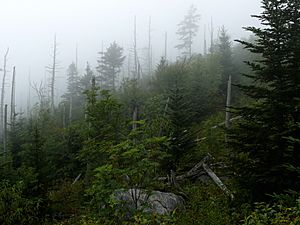
The spruce-fir forest is a leftover from the ice ages. Back then, the Smokies were too cold for hardwood forests. Even though temperatures rose, the spruce-fir forest survived on the harsh mountain tops, usually above 5,500 feet (1,676 meters). About 10,600 acres (43 km²) of this forest are old-growth.
This forest mainly has two conifer trees: red spruce and Fraser fir. The Fraser firs were once very common, but a tiny insect called the balsam wooly adelgid killed most of them in the 1960s. So, red spruce is now the main tree here. Some red spruces are thought to be 300 years old and over 100 feet (30 meters) tall.
Unlike northern spruce-fir forests, the ones here have a thick understory of broad-leaved plants. These include catawba rhododendron and thornless blackberry. The ground is often dark, so you'll find shade-loving plants like ferns and over 280 species of mosses.
Wildflowers: A Burst of Color
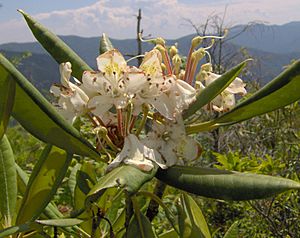
The Great Smoky Mountains National Park is famous for its over 1,400 flowering plant species. Many wildflowers grow in the mountains and valleys. You can see bee balm, Dutchman's breeches, and various trilliums. Even delicate orchids grow here.
There are two native kinds of rhododendron. The catawba rhododendron has purple flowers in May and June. The rosebay rhododendron has white or light pink blooms in June and July. The orange or red flame azalea also blooms around the same time.
These blooms start at lower elevations and move higher up the mountains. In autumn, the opposite happens. The mountaintops get covered in frost, while the valleys still have bright, colorful leaves.
The Park's Fauna: Wildlife Wonders
The Great Smoky Mountains National Park is home to 65 types of mammals, over 240 kinds of birds, 43 types of amphibians, 67 kinds of fish, and 40 types of reptiles.
Mammals: From Bears to Elk
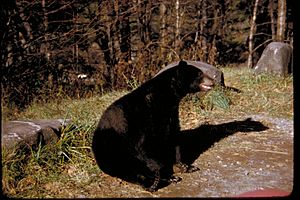
The American black bear is probably the most famous animal in the park. It has become a symbol of the Smokies. The park has the largest population of black bears east of the Mississippi River. Most adult bears weigh between 100 and 300 pounds (45-136 kg). Some have been seen weighing up to 600 pounds (272 kg)! About 1,900 black bears live in the park.

The Smokies also have 27 types of rodents, like beavers, woodchucks, and chipmunks. Twelve types of bats live here, including the endangered Indiana bat. Other mammals include white-tailed deer, bobcats, raccoons, and Virginia opossums.
Coyotes have moved into the area recently and are now considered native. You can also find red foxes and gray foxes.
In 2001 and 2002, elk were brought back to the park. Now, you can often see them in the Cataloochee area. European wild boars were also brought here long ago. They are a problem because they dig up and destroy plants. The park even has a program to pay people to hunt them.
Birds: Feathered Friends of the Smokies

The Smokies have many different kinds of birds because of the various forest types. Almost 120 bird species use the park as a breeding ground. Many other birds stop here during their long migrations.
Birds like the red-eyed vireo and wild turkey live in the lower forests. Birds that prefer cooler weather, like the raven and black-capped chickadee, are found in the spruce-fir forests. Bald eagles and golden eagles have been seen all over the park. You might also spot peregrine falcons and red-tailed hawks. Owl species include the barred owl and eastern screech owl.
Reptiles and Amphibians: Salamander Capital
The Great Smoky Mountains National Park is known as the "Salamander Capital of the World." It has one of the most diverse salamander populations anywhere! Five of the world's nine salamander families live here, with up to 31 different species. The red-cheeked salamander is found only in the Smokies.
Other salamanders include the shovelnose salamander and the eastern red-spotted newt. The hellbender, a huge salamander that can grow to 29 inches (74 cm) long, lives in fast-moving streams. The park also has 14 species of frogs and toads, like the American toad and the spring peeper.
You can find eight types of turtles, nine types of lizards, and 23 types of snakes in the park. Most snakes are harmless, like the black rat snake and the corn snake. There are two types of venomous snakes: the timber rattlesnake and the copperhead. Both are pit vipers.
The eastern box turtle is the most common turtle. Lizards include the eastern fence lizard and green anole. The rarest lizard is the eastern slender glass lizard, which looks like a snake because it has no legs.
Fish and Insects: Tiny Wonders
The park's streams are home to fish like trout, lamprey, and minnows. About 1,073 miles (1,727 km) of streams support fish. The brook trout is the only trout species native to the area. However, rainbow trout and brown trout were brought here in the 20th century. These larger trout often outcompete the native brook trout. So, most brook trout are found in streams above 3,000 feet (914 meters) where it's cooler.
The park also has four protected fish species: the smoky madtom, yellowfin madtom, spotfin chub, and duskytail darter.
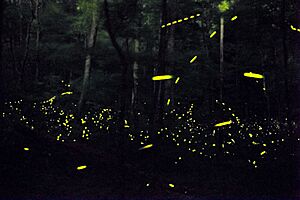
More than 9,000 species of insects have been found in the park. This includes many butterflies, moths, beetles, and bees. Insects are very important for pollinating plants and helping wood break down.
A special insect is the firefly Photinus carolinus. These fireflies can flash their lights at the same time! This amazing display happens in mid-June near Elkmont, Tennessee. Many visitors come to see this "celebrity insect" show.
Fun Activities and Attractions
The Great Smoky Mountains National Park is a very popular place to visit. It's been the most visited national park for many years. In 2021, over 14.1 million people visited! This is almost twice as many as the Grand Canyon.
Towns around the park, like Gatlinburg and Cherokee, get a lot of money from park tourism.
The park has three main entrances: in Gatlinburg, Cherokee, and Townsend. It's free to enter the park, but there is a fee for parking. U.S. Route 441 (Newfound Gap Road) is the main road through the park. It connects Cherokee and Gatlinburg.
The two main visitor centers are the Sugarlands Visitors' Center near Gatlinburg and the Oconaluftee Visitor Center near Cherokee. These centers have rangers, exhibits about wildlife and history, and sell maps and souvenirs.
Hiking and Trails: Explore the Outdoors
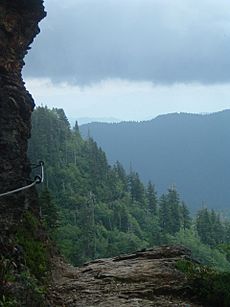
There are 850 miles (1,368 km) of trails and unpaved roads for hiking in the park.
About 71.6 miles (115.2 km) of the famous Appalachian Trail (AT) are in the park. The AT follows the top of the mountains and the state line. Kuwohi is the highest point along the entire AT. There are 12 trail shelters along the AT for backpackers.
Mount Le Conte is a very popular hiking spot. Five trails lead to its summit. The Alum Cave Trail is the most used. It has great views and cool spots like Alum Cave Bluffs. You can even stay overnight at the LeConte Lodge near the summit. It's the only private lodging inside the park.
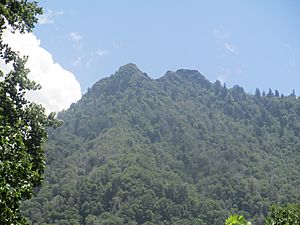
Another popular trail goes to the top of the Chimney Tops. It's a tough hike, but the views are amazing. However, you can't go to the very top anymore because of damage from the 2016 Great Smoky Mountains wildfires.
The Laurel Falls and Kuwohi trails are easy, paved paths. The Laurel Falls Trail leads to a beautiful 80-foot (24-meter) waterfall.
Besides day hikes, you can also go backpacking and camping. You need a permit for backcountry camping. There are also shelters for overnight stays.
Sightseeing: Scenic Drives and Views
The most visited place in the park is Cades Cove. It's a wide, open valley with amazing mountain views. Cades Cove has many old buildings like log cabins, barns, and churches. An 11-mile (18 km) one-way loop road goes around Cades Cove. You can drive or bike to see how people lived long ago. Other historic areas include Roaring Fork and Cataloochee.
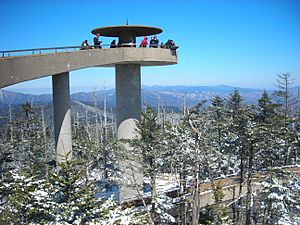
U.S. Route 441 (Newfound Gap Road) lets you drive to many trailheads and viewpoints. Newfound Gap is a famous spot at 5,048 feet (1,539 meters) high. It's on the state line between Tennessee and North Carolina. President Franklin D. Roosevelt dedicated the park here in 1940. On clear days, Newfound Gap has incredible views.
There's a 45-foot (14-meter) observation tower on top of Kuwohi. You can walk a half-mile (0.8 km) trail to get there. From the tower, you get a 360-degree view of the mountains. On a clear day, you can see up to 100 miles (161 km)!
The park has other scenic drives too. Lakeview Drive goes along Fontana Lake. The Foothills Parkway offers great views of the mountains and the Tennessee Valley. The Blue Ridge Parkway also starts near the park.
Other Fun Activities
After hiking and sightseeing, fly fishing is very popular in the park. The streams are known for healthy trout. The brook trout is native, but brown trout and rainbow trout were also introduced. There are rules about how you can fish.
You can also go horseback riding (on certain trails), bicycling (bikes can be rented in Cades Cove), and water tubing. Many roads in the park are popular with car and motorcycle fans. A section of U.S. Route 129 is called the "Tail of the Dragon" because it has so many curves!
If you want to camp in the backcountry, you need a permit. Reservations are required for shelters and campsites. You can usually stay one night in a shelter or three nights at a campsite.
From late May to early June, you can see a special sight in the Elkmont area. The Photinus carolinus fireflies put on a synchronized light show! They are the only fireflies in America that can flash their lights together.
A Look at the Park's History
Early People and the Cherokee
Native Americans have probably hunted in the Great Smoky Mountains for 14,000 years. Old tools and pottery have been found in the park.
Later, the Cherokee people moved into this area. By the time the first European settlers arrived, the Cherokee controlled much of the region. They called the mountains Shaconage, meaning "place of blue smoke." One Cherokee story tells of a hidden magical lake called Atagahi. Another tells of a medicine man searching for the Uktena.
Most Cherokee villages were in the river valleys around the Smokies. The village of Oconaluftee was the only known permanent Cherokee village inside what is now the park. Some seasonal settlements were in Cades Cove and the Hazel Creek valley.
European Settlers and Changes
European explorers and settlers started arriving in the mid-1700s. This led to conflicts with the Cherokee. By 1805, the Cherokee had given control of the Smokies to the U.S. government.
In 1838, most of the Cherokee were forced to move west on the Trail of Tears. But a few, with help from William Holland Thomas, managed to keep their land. Their descendants make up the Eastern Band of Cherokee Indians today.
In the late 1700s and early 1800s, settlers began building farms and communities in the Smokies. Families like the Ogles and Olivers were among the first. They built log cabins, barns, and other farm buildings. Churches were also very important to these early communities.
The geography of the Smokies meant that large farms with many workers were rare. This was different from other parts of the South. During the American Civil War, people in the Tennessee side of the Smokies mostly supported the Union. People on the North Carolina side mostly supported the Confederates. There were no big battles, but small fights and stealing happened.
Logging and the Idea of a Park
In the late 1800s and early 1900s, big logging companies came to the Smokies. They used new railroads and saws to cut down many trees. By the 1930s, two-thirds of the old forests were gone. The National Park Service says 80% of the Smokies was clear-cut.
People saw that the beautiful forests were being destroyed. So, in the early 1900s, people started working to create a national park. They wanted to protect the land.
In 1923, Anne May Davis from Knoxville had the idea for a national park here. She and others formed the Great Smoky Mountains Conservation Association. They worked hard to get support. In 1924, a committee recommended creating parks in the Smokies and Virginia.
President Calvin Coolidge signed a law in 1926 to allow the park. But there was no federal land yet. The states of Tennessee and North Carolina agreed to buy land. Private citizens also raised money. Then, a rich businessman named John D. Rockefeller Jr. gave $5 million in 1928, which was a huge amount of money!
Creating the park was difficult. They had to buy land from thousands of small farms and logging companies. Many mountain families had to move from their homes. But by 1932, most of the land was bought.
During the Great Depression, federal groups like the Civilian Conservation Corps hired workers. They built trails, roads, and other things in the park. The Great Smoky Mountains National Park was officially created on June 15, 1934. President Franklin D. Roosevelt formally opened it in 1940 at Newfound Gap.
Recent Park History
After World War II, more and more people visited the park. The government improved roads and built new facilities. Towns like Gatlinburg and Pigeon Forge grew with new tourist attractions.
The famous singer Dolly Parton, who grew up nearby, helped bring even more attention to the park. In 1986, she co-founded the theme park Dollywood. This led to even more tourism in the area.
The Great Smoky Mountains National Park was named an International Biosphere Reserve in 1976 and a UNESCO World Heritage Site in 1983.
In 2016, a series of wildfires burned about 17,900 acres (72 km²) in the park and nearby areas. The fires caused a lot of damage and forced many people to leave their homes. They were the deadliest fires in the eastern U.S. in a long time.
In 2023, the park was featured on a USPS Priority Mail Express stamp. This shows how important and beautiful the Great Smoky Mountains National Park is.
See also
 In Spanish: Parque nacional de las Grandes Montañas Humeantes para niños
In Spanish: Parque nacional de las Grandes Montañas Humeantes para niños
- Great Smoky Mountains Association
- Great Smoky Mountains Heritage Center
- Wildflowers of the Great Smoky Mountains
- List of birds of Great Smoky Mountains National Park
- List of national parks of the United States
|


